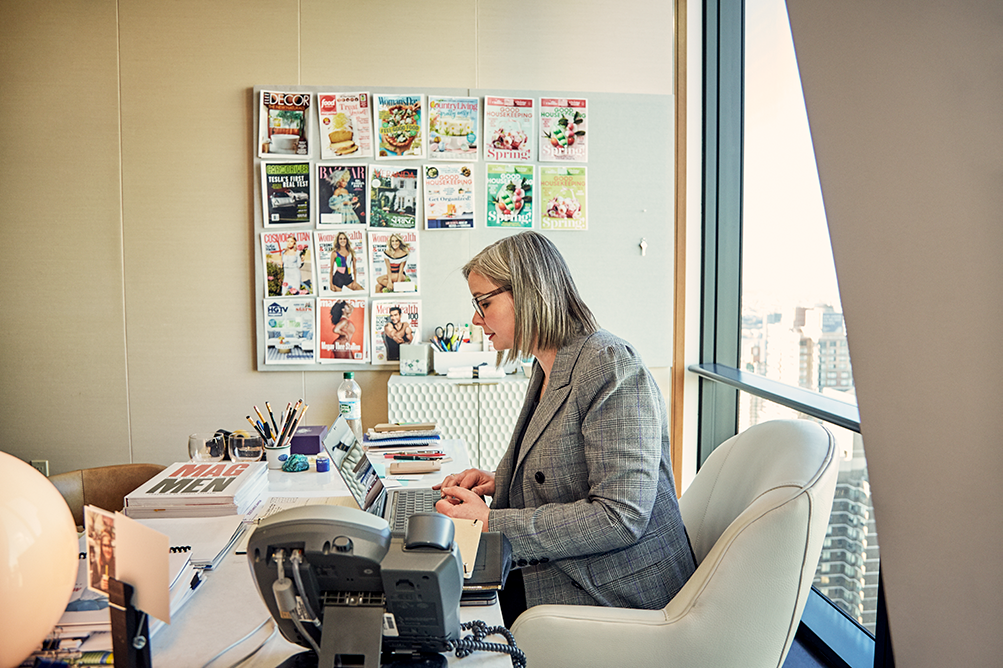
Kate Lewis at Amherst
Major: European studies
Outside class: She was on staff at the feminist magazine Madness, This and guested on a radio show called Guinea Pigs Amok with her friend Meredith (Kahn) Rollins ’93, former editor-in-chief at Redbook, a Hearst magazine.
Favorite place on campus: Frost Library, the periodicals room. She says: “Remember how magazines were on those long sticks then?” For a change of scene, she hung out at the UMass library too.
Campus job: Dishwasher at Val, breakfast shift
Hardest class: Economics 101, which she dropped. “I was so out of my depth,” she says. “I had never had that school experience before, of having to admit full defeat.”
Study abroad: Oxford
Thesis title: “The Empire in England: The Imperial Connection in William Thackeray’s The Newcomes”
Just because Kate (Westerbeck) Lewis ’94 studied at Oxford doesn’t oblige me to quote the Oxford English Dictionary. But when you write a profile of one of today’s real visionaries in the magazine world—she’s the chief content officer at Hearst, overseeing 25 titles, including Cosmopolitan, Esquire and Good Housekeeping—and then you run that profile in a magazine for an alumni body in which 80 percent hold advanced degrees, with lots of them professors themselves, you’d better confront the ivory-tower vs. popular-press snobbery head-on. And you’d better go to a venerated source.
Lewis, who has a lavish sense of humor and whose motto is “Enter smiling,” would relish the snooty OED entry for the noun form of magazine. It cites Alexander Pope, who haughtily lumps magazines in with “all the Grub-street race.” It quotes the critic F.R. Leavis on a Joseph Conrad novel: “Conrad must here stand convicted of borrowing the arts of the magazine-writer.” It also decrees that the word magazine “(rather than periodical) typically indicates that the intended audience is not specifically academic.”
Might there be a soupçon of judginess in that last one, a signaling of lesser pedigree? Maybe I’m being paranoid (being a magazine writer and all), for there are loftier definitions out there too: Did you know, for instance, that magazine once meant a country rich in natural products? It can also refer to a ship that supplies provisions, a locale to cache arms or a portable receptacle for objects of value. The word itself comes from the French magasin, meaning a warehouse or shop—whether brick and mortar, paper and ink, or pixels and code, each magazine displays articles and invites browsing.
When you think of which ones you’ve happily browsed over your lifetime, maybe you flash on Mad (oh, those movie parodies—Star Bores and Inadiaper Jones!) or GQ or Ebony or National Geographic. You may mourn all the magazines that have succumbed in recent years (RIP, Details, Spin, Gourmet). You may worry about the future of magazines, and wonder how the form has adapted (or not) to the digital age.
Kate Lewis forges and finesses this future every day. The delivery mechanism of magazines is radically changing, but the secret is to tap the power of the magazine brand across any platform. That’s what she told Samir Husni (a.k.a. “Mr. Magazine”), director of the Magazine Innovation Center at the University of Mississippi School of Journalism and New Media: “You can have a brand be executed across any of the places that we publish and be pretty darned successful in those places, with the right ambition.”
To that end, her topmost mission is to integrate print and digital teams, and have them do a Spock mind-meld about magazine content. It’s all about paying scrupulous attention to the metrics, but also about producing delight, which can’t be measured. At Hearst, they’re trying to convert robust monthly titles like Elle, Popular Mechanics and O, the Oprah Magazine into a pleasure-sparking daily routine for readers. “From months to moments,” to quote Troy Young, Lewis’ boss and the president of Hearst Magazines.



